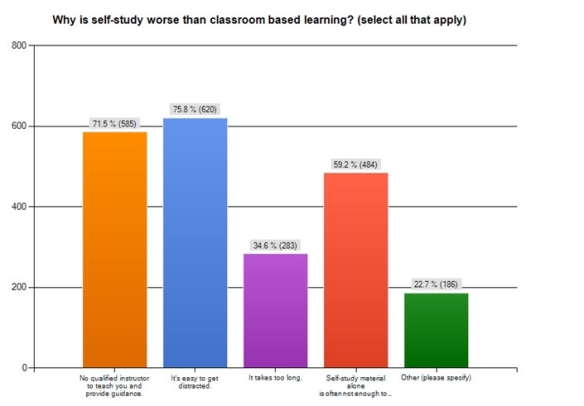
This is a graph detailing the results from a survey to IT professionals about the weaknesses of self-study. Perhaps they aren’t inherent weaknesses, but rather just things that self-studiers need to be aware of and overcome.
僕の日本語勉強:4つの大進歩時期(2)
Self-study is not for the faint of heart.
Japanese Was In My Hands, But Actually… (June 2010)
Let me be clear from the start: I’m not against self-study. Nor am I inherently pro-classes, as ironic as that might be for a professional teacher. But when I started my time of self-study, my Japanese progress was marked with…a stark lack of progress.
I did make some gains. I picked up words here and there. Having my rivals helped me keep from doing nothing. But as someone who was successful in the classroom environment, I was bad at giving myself direction. AJATT‘s head honcho Khatzumoto basically states that if you make everything you touch Japanese, you don’t need direction—you’ll pick up Japanese because it’s the only thing you can pick up. Benny from FluentIn3Months forces you into a habit of talking daily and having mini-goals. At this time, I didn’t really know either of the above people nor the legions of language self-studiers all over the internet.
My environment only had Japanese occasionally: a show every few days, sometimes a Japanese thing or two that came up. Of course I picked up something, as my goal was to still be studying. But it couldn’t compare to the progress I’d made previously. I had no goals or time limits: pick things up when they happen to get picked up. Progress was slow.
On the cup half-full side, I was making progress. My Japanese was stagnating, but not necessarily dropping. I started tutoring Japanese, reinforcing those things I had previously learned. On the side, I tried teaching Japanese to small classes of college students for free. Those initial classes didn’t go so great—I had little confidence in what I was teaching.
In July 2011, I went to teach English in China. During this time, my exposure to Japanese became even less frequent, although in the 6th months I was there, I did manage to beat both the Japanese version of The Last Story and Xenoblade, as well as playing a bit of some other games. My Chinese had developed so quickly in the six months that when reading the game’s dialogue out loud, it often became a mix of Japanese and Chinese, depending on which pronunciation came to me more easily.
I was given the opportunity to teach a housewife English through Japanese, but this failed pretty spectacularly, and she cancelled after the trail class. My Japanese wasn’t enough.
My Japanese became pretty rusty during this time, and almost certainly dropped in level. But I did get to use it occasionally. A Korean man we’ll call Mr. Lee would have conversations with me that switched abruptly from Japanese to English to Mandarin without a moment’s notice, and I followed along pretty well.
If my Japanese improved at all during this time, it was a result of two elements: understanding that I didn’t need to understand everything, and understanding a greater number of kanji, both the result of studying Chinese in China.
When I came back to America, I had everything I needed to become a better self-learner, even if I didn’t quite know it yet.
Confidence is the Key to Fluency (January 2012)
BREAKTHROUGH 二: Confidence
I’d made some great progress in Chinese during my time in China (which has since gone to the gutter) at the expense of my Japanese. When I came back, however, a few changes to my routine made my casual attempts at Japanese have much greater impact.
For one, after teaching in China, my ability to teach had improved significantly. One of the biggest, simplest improvements came to my confidence. When I had to teach elementary Japanese to people, whether it was in the classroom setting or tutoring, I knew how important confidence was. Even the things I wasn’t actually confident in, I had to pretend I was while researching it on the side (so I could correct myself in a follow-up class). This let me learn to speak Japanese with an odd, new confidence that I practiced in my classes.
I believe one of the marks of a fluent speaker is not the number of words or the variety of grammar they use, but rather the confidence they have. And maybe pronunciation helps. In other words, someone who is confident with 100 words sounds much more fluent than someone uncertain with 1000.
I remember wanting to demo an online conversation with a random Japanese person in front of my class. I was nervous, but I knew I needed to do this to help my students feel more comfortable doing it. Online conversations are one of the best tools in language learning, and utilizing it would be greatly beneficial. Indeed, I understood this as well, but I didn’t like doing them. They were too embarrassing. Even when in-person meetings were fine, talking to someone online was nerve-wracking. When I finally did it for my class, I actually felt more comfortable talking to Japanese people online myself. The confidence I needed for the classroom, while just an act at the time, became the mode I used for future online conversations.
In spite of the boost that the confidence gave me and the fact that I finally felt fine talking to people, my breakthrough didn’t translate well into increased vocabulary. I got to practice those 100 words I knew. New words however, weren’t sticking.
I was cementing my Japanese foundation, but I wasn’t yet building my Japanese house. It was a damn solid foundation, mind you, but you wouldn’t want to live in it.

Pingback: My Four Breakthroughs in Japanese (1) | The Japanese Role Playing Game
Pingback: My Four Breakthroughs in Japanese (3) | The Japanese Role Playing Game
Pingback: My Four Breakthroughs in Japanese (4) | The Japanese Role Playing Game